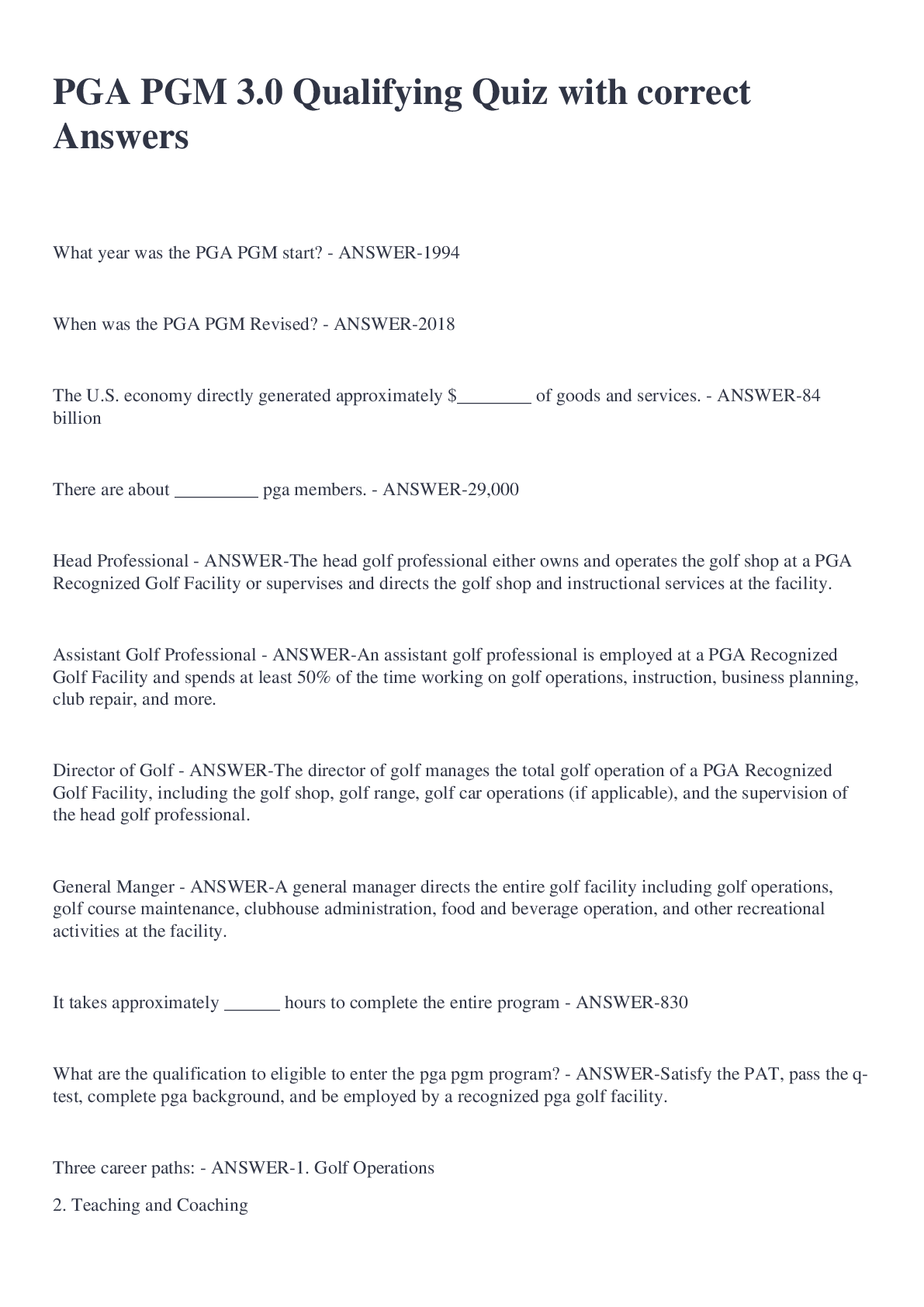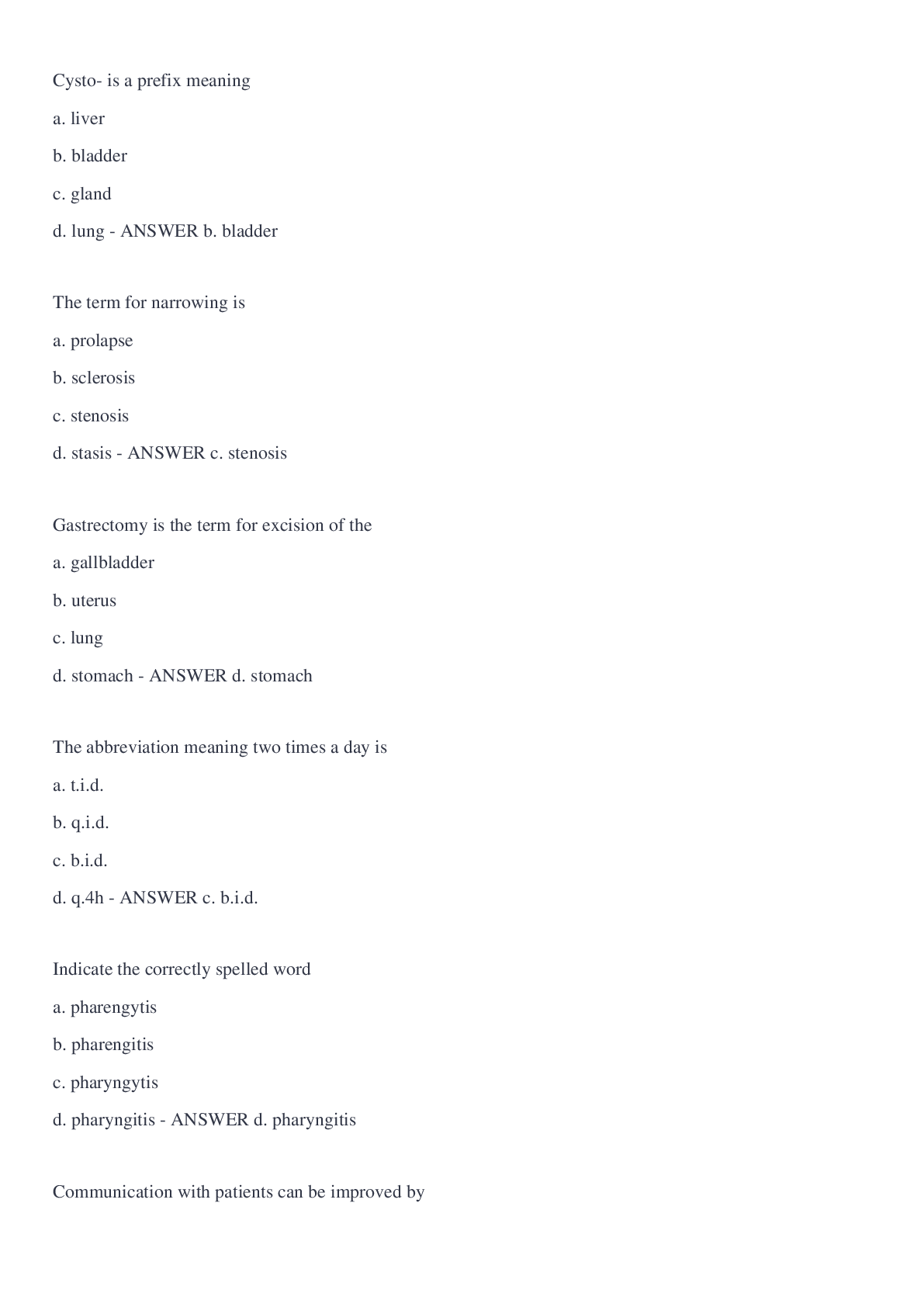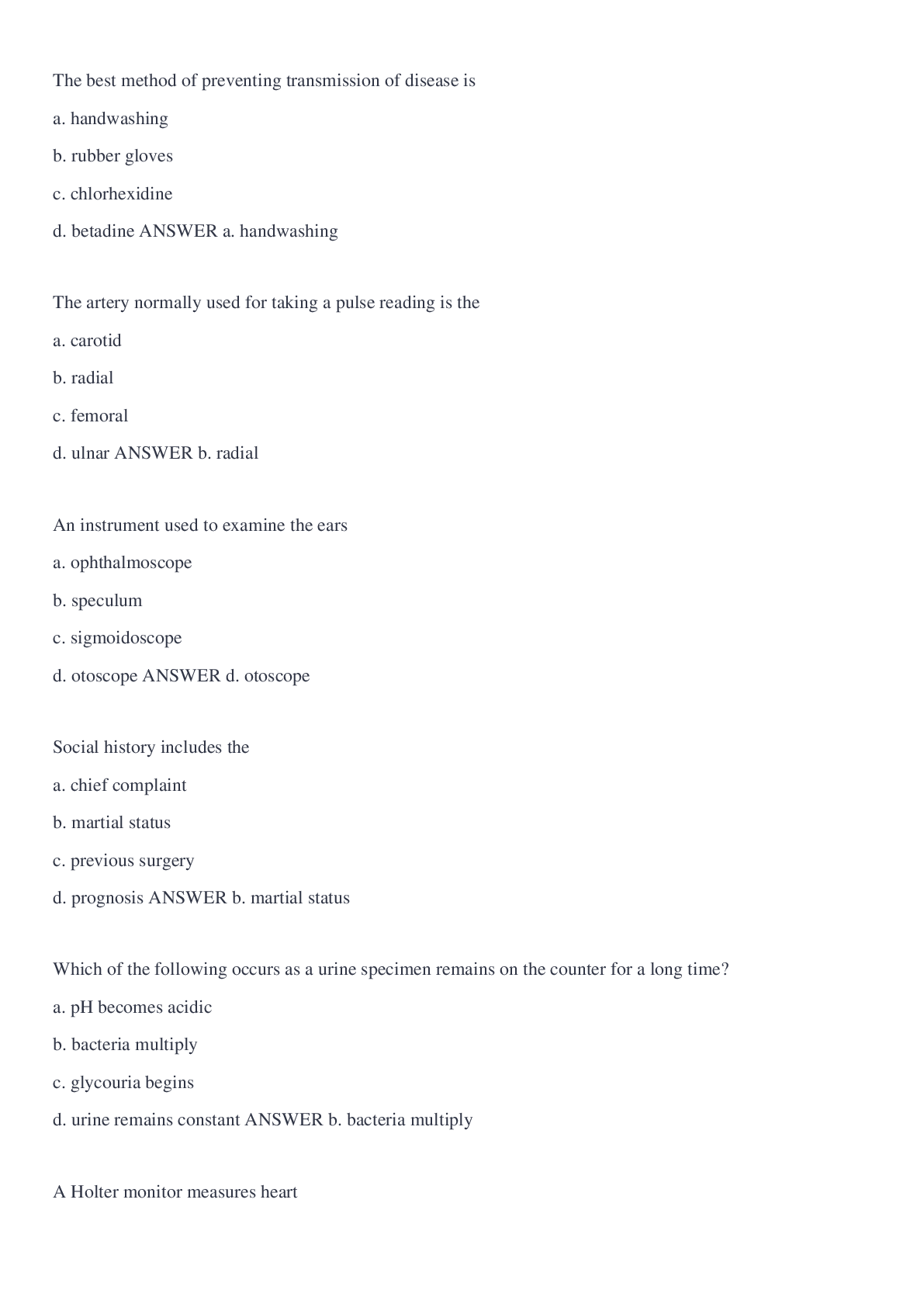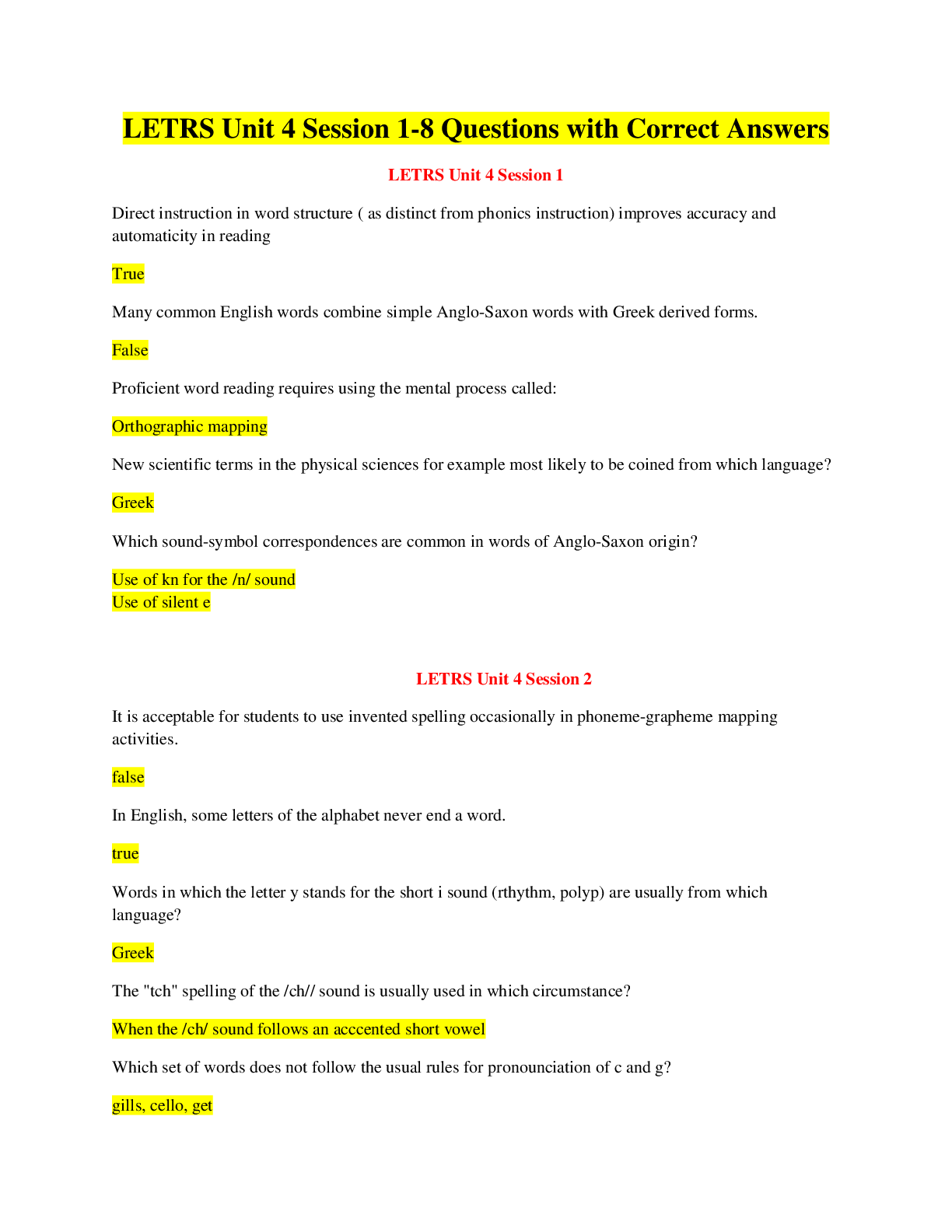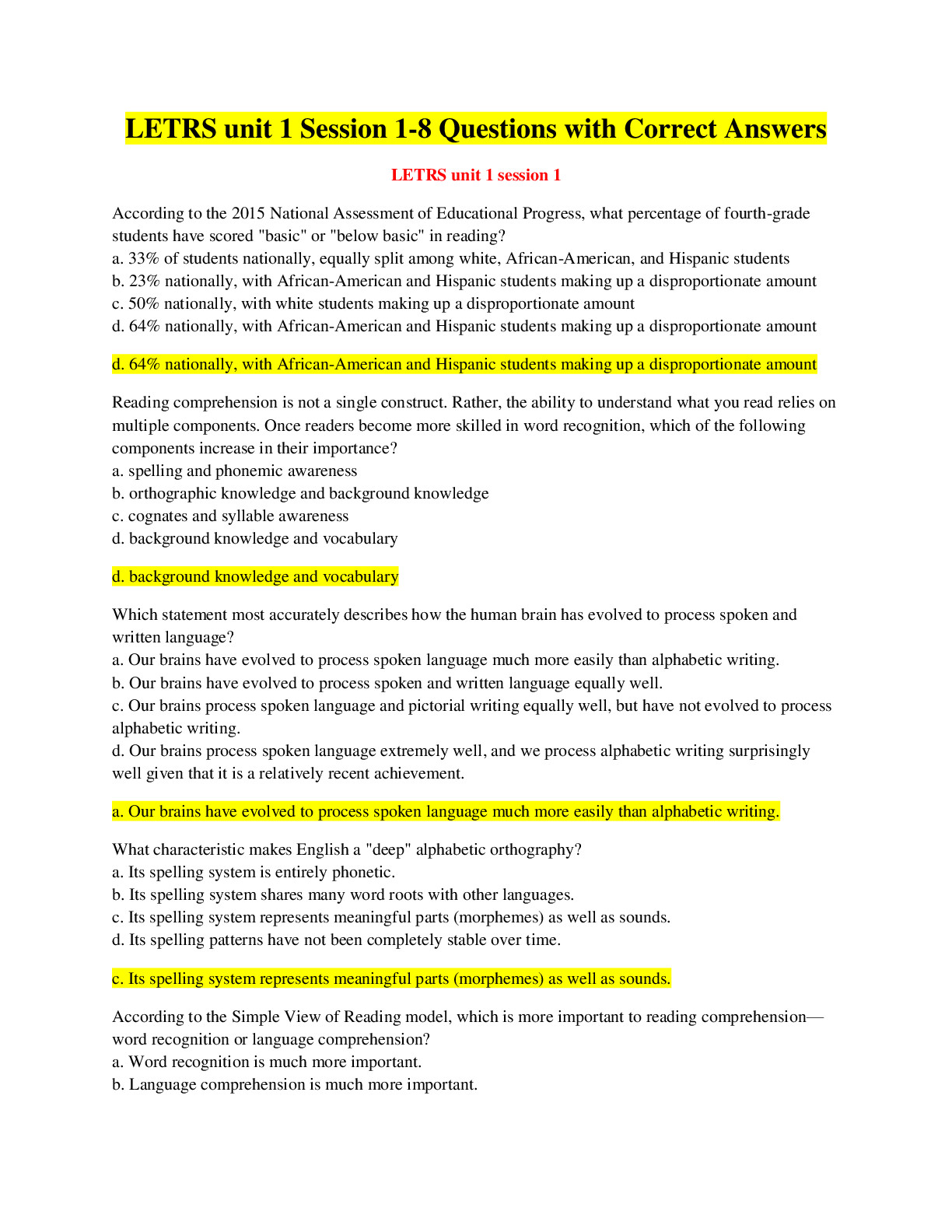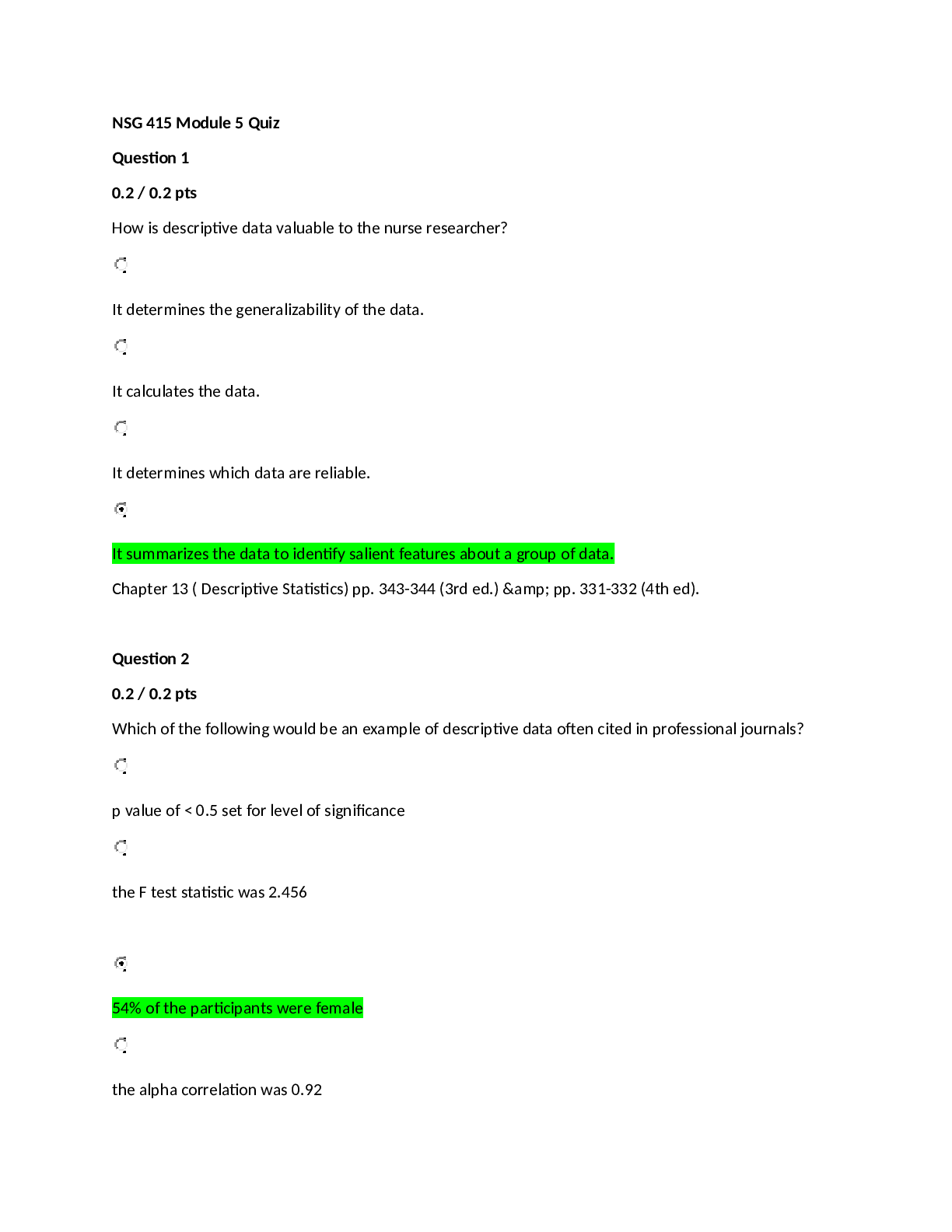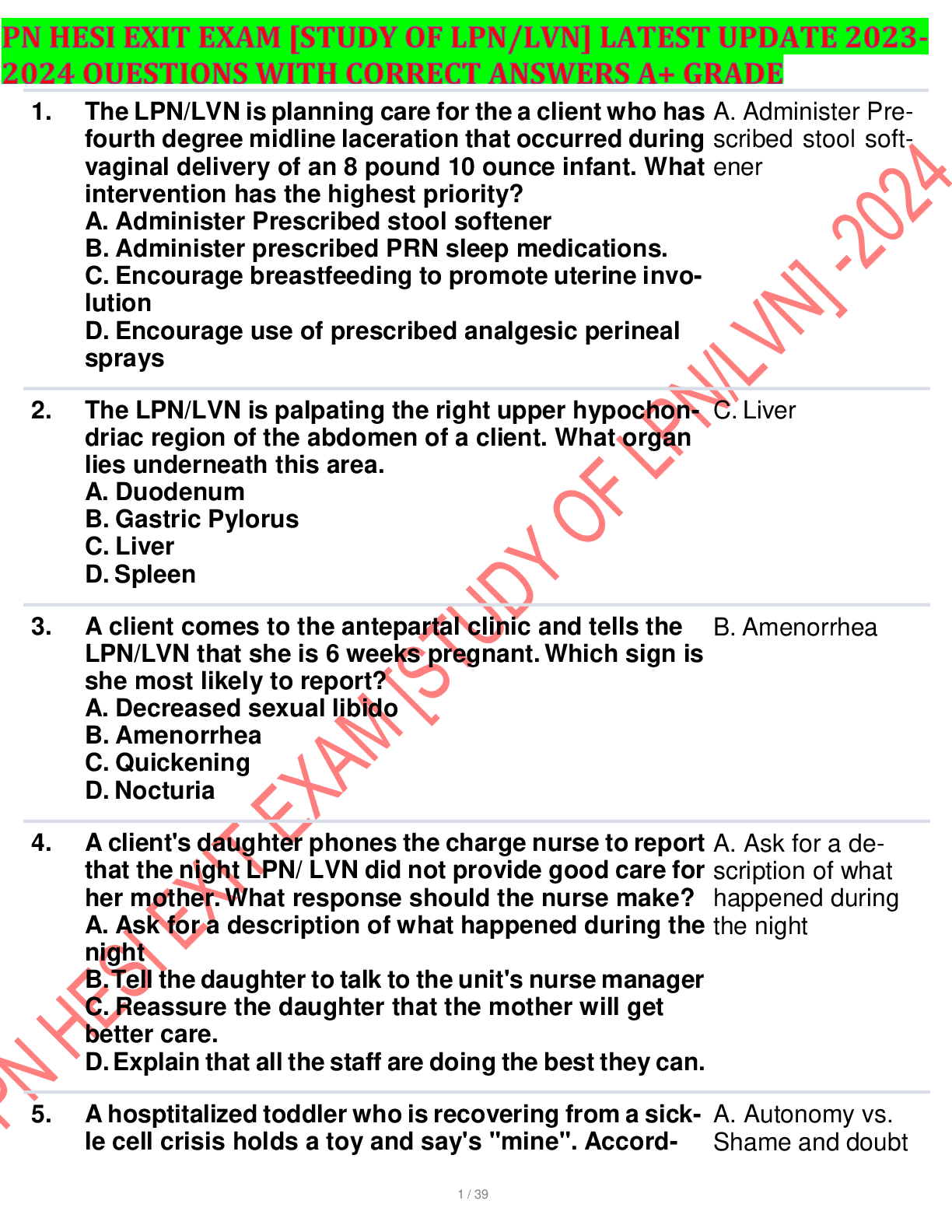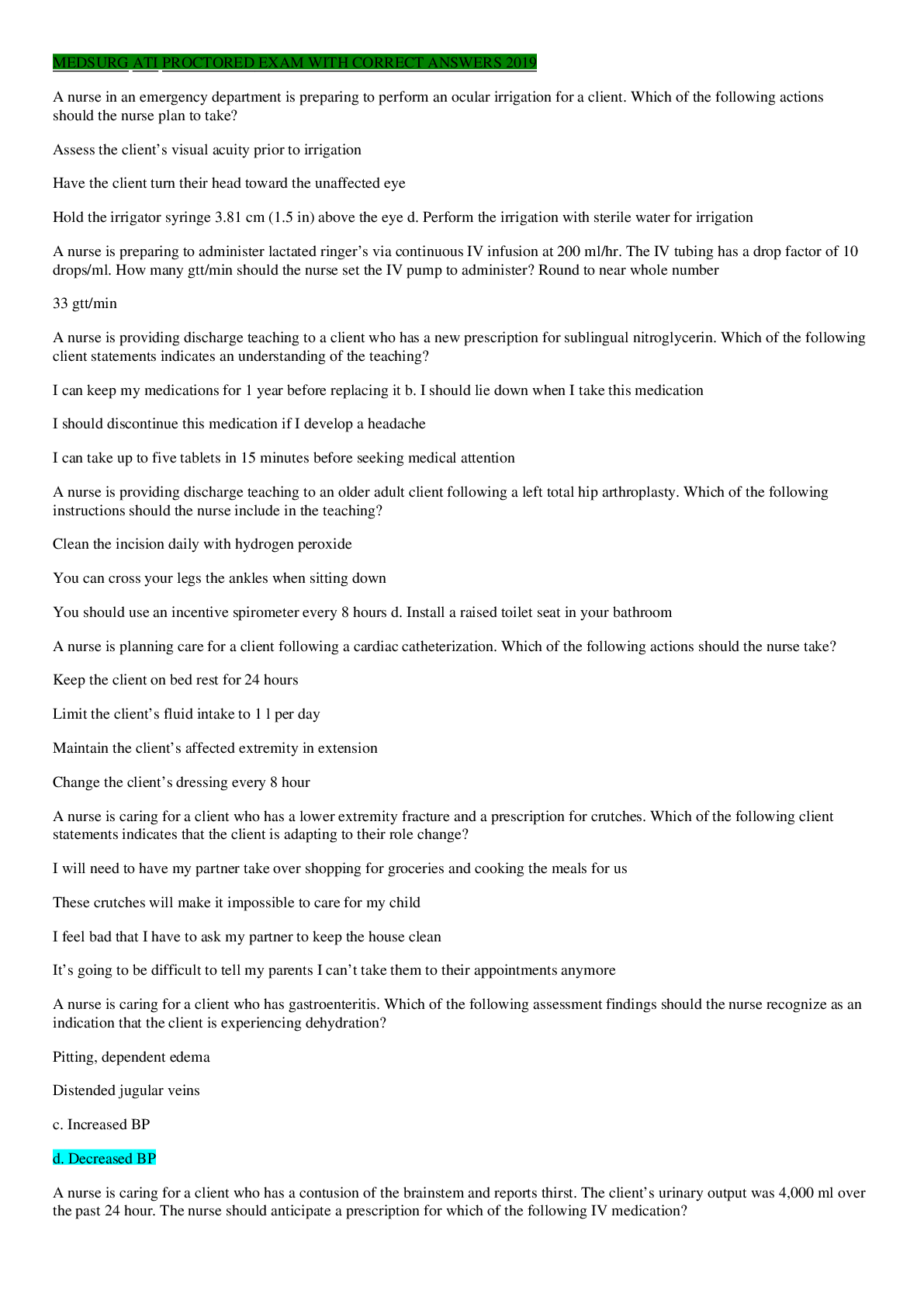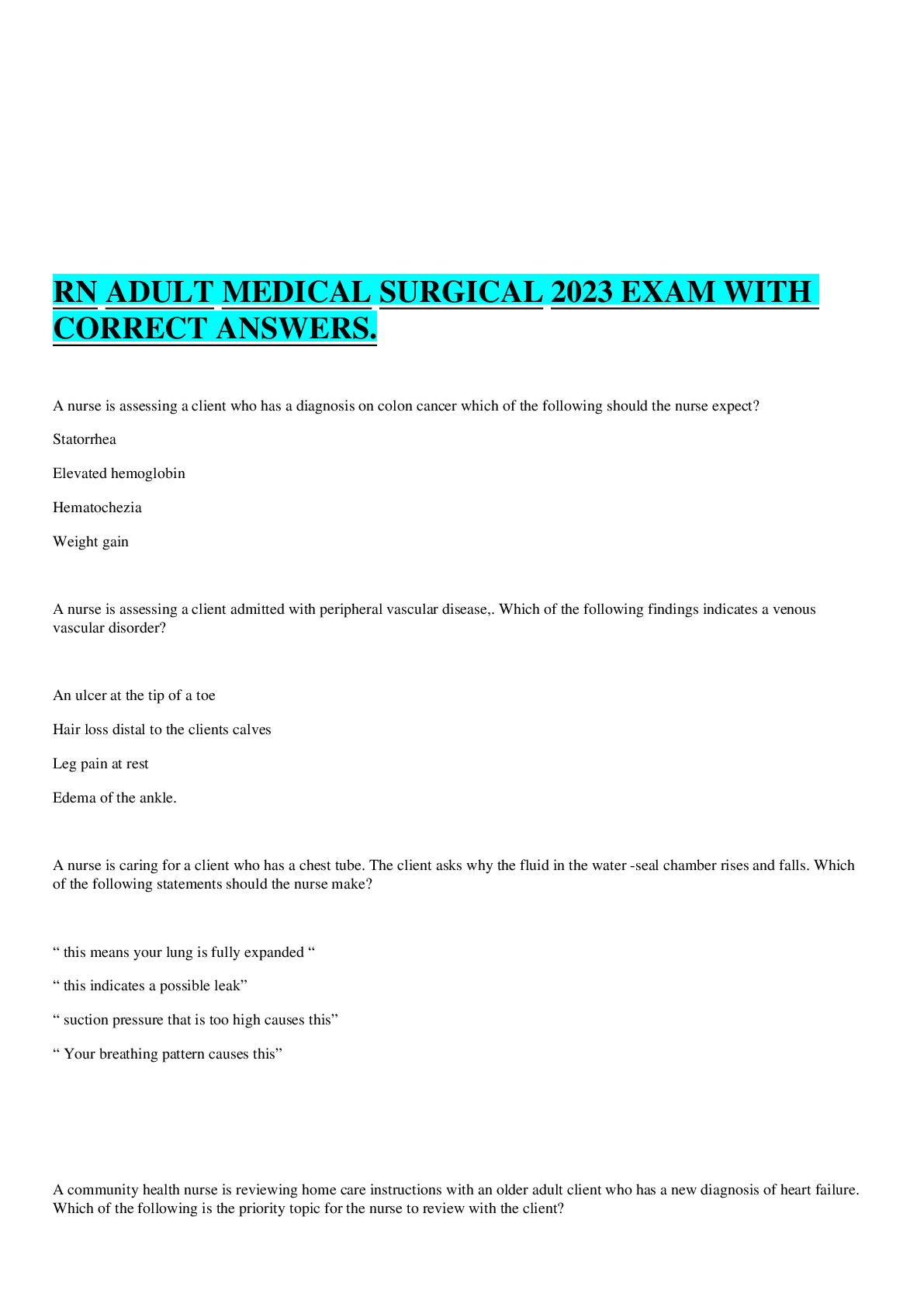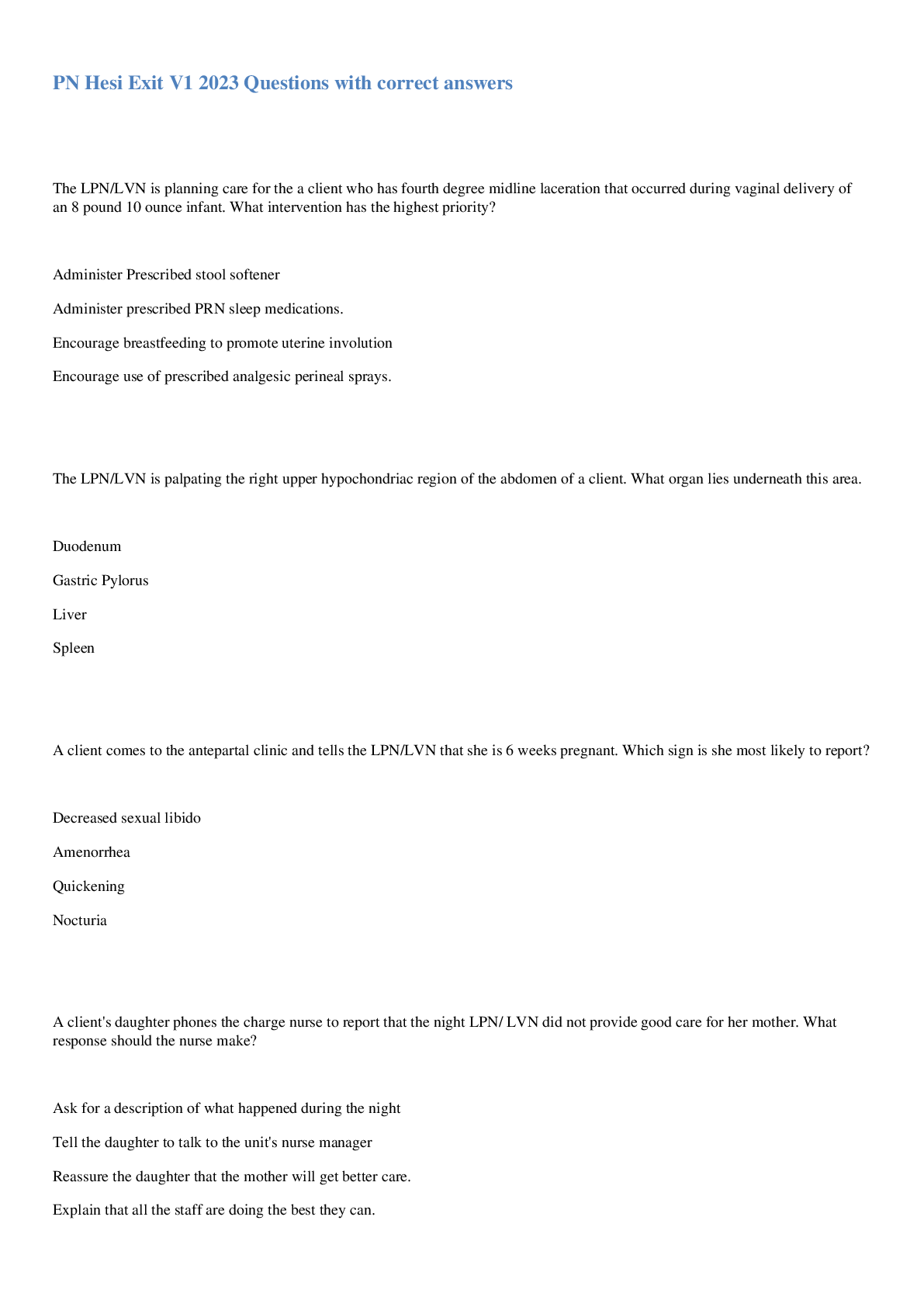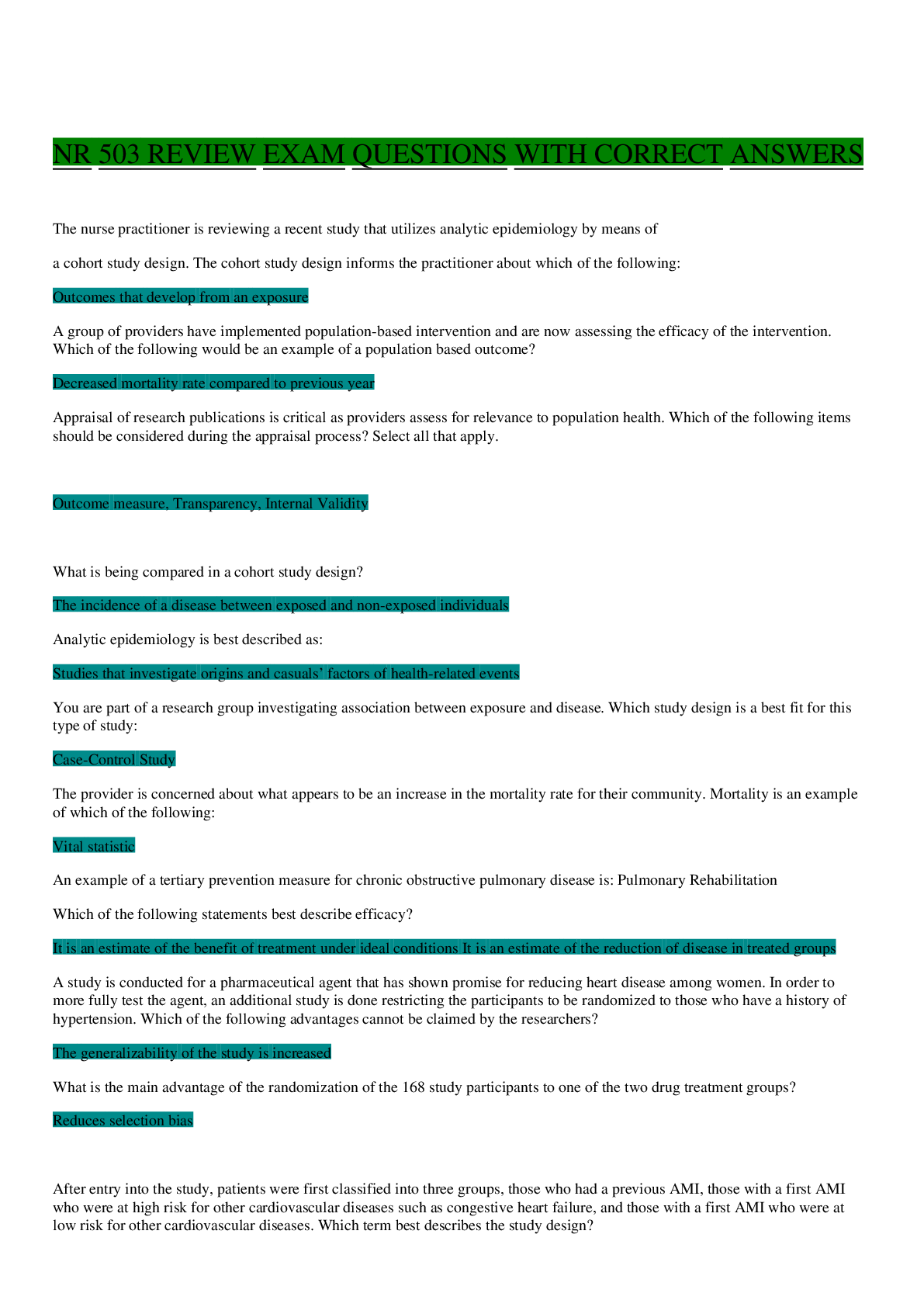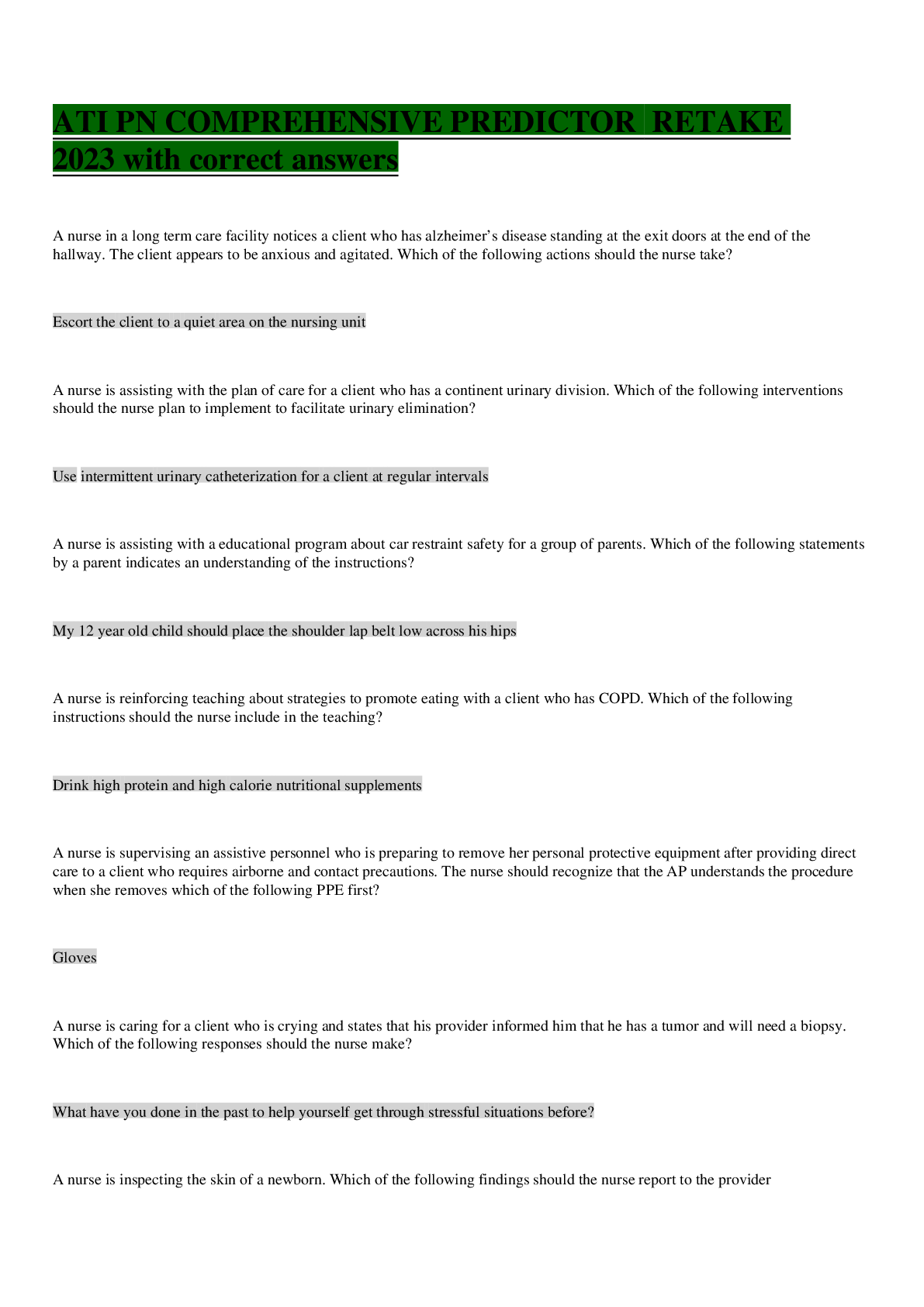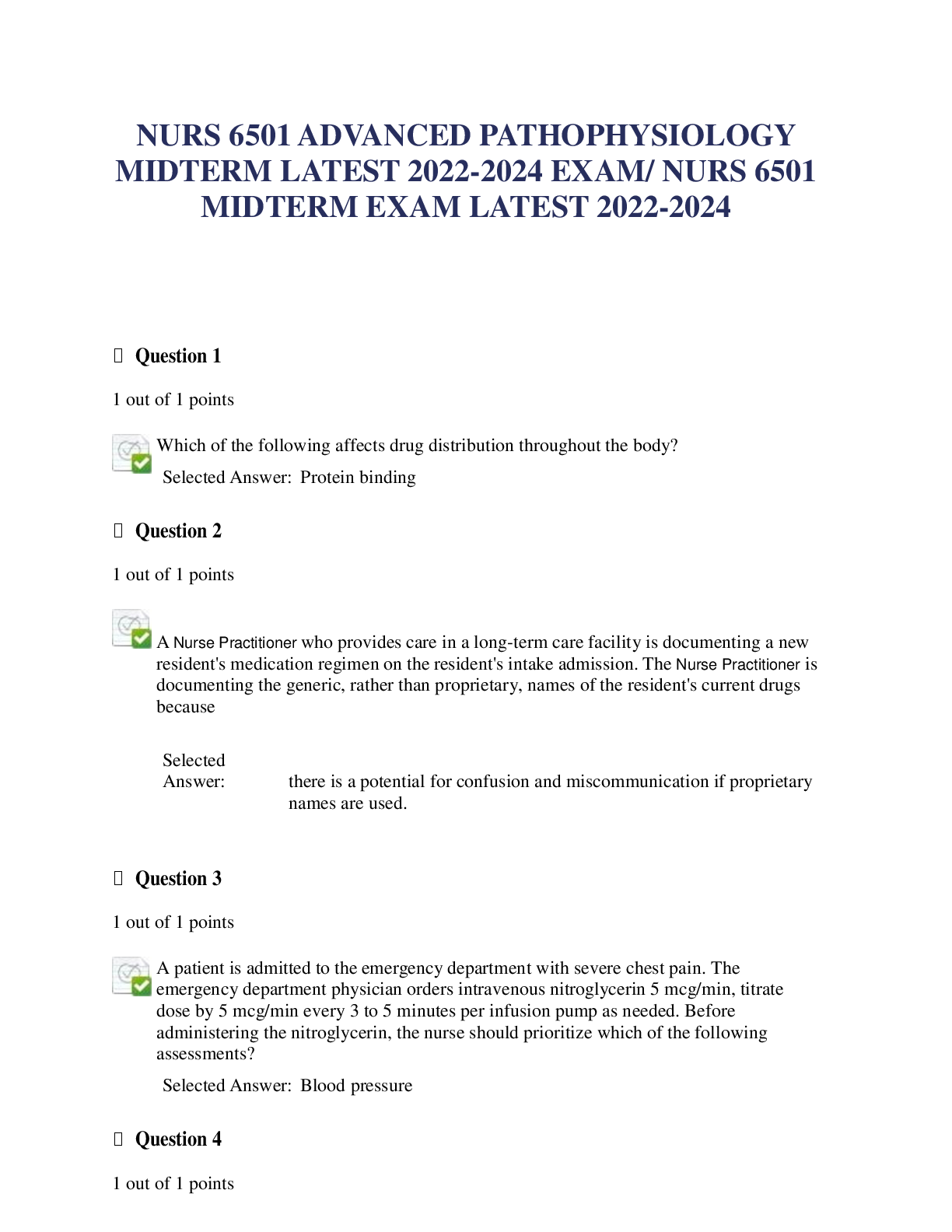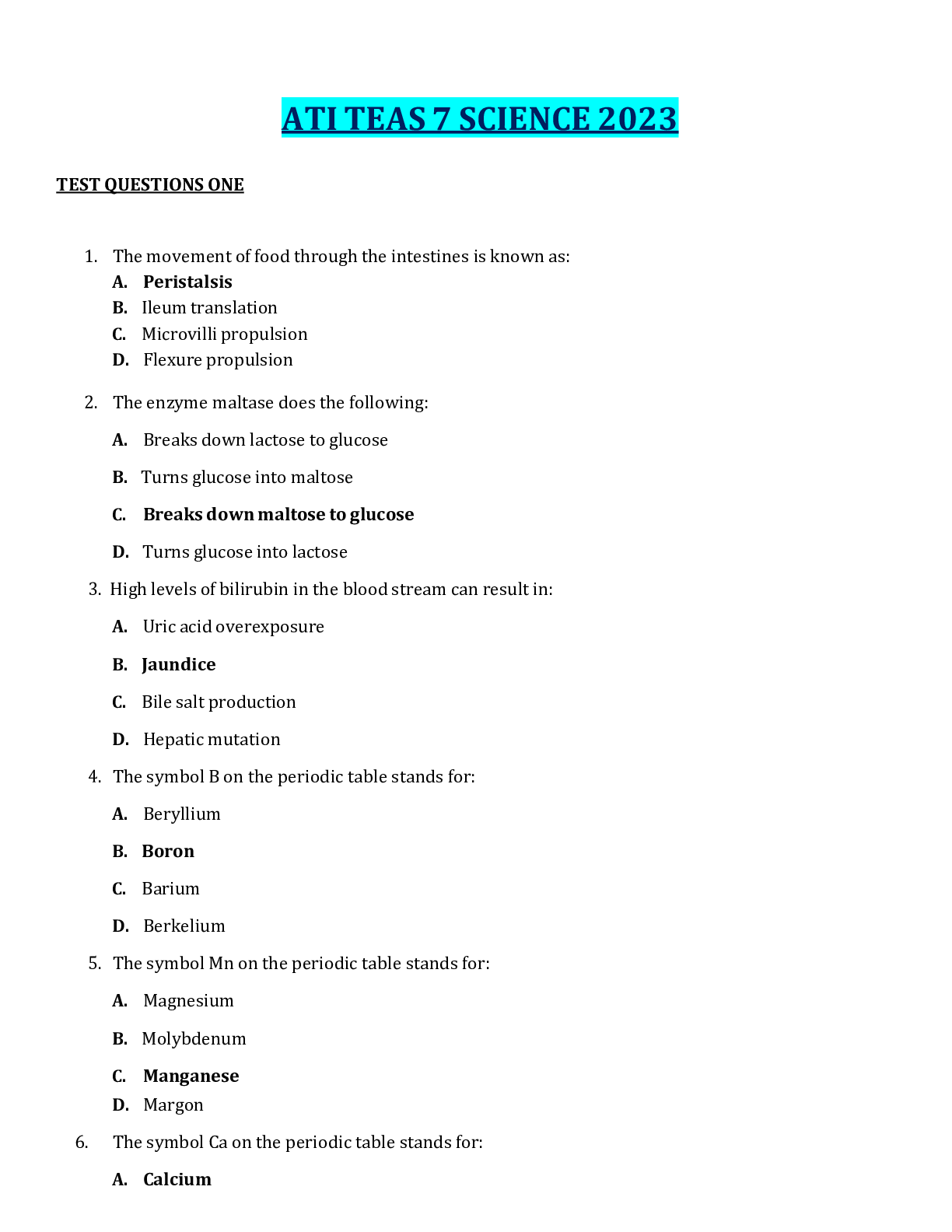*NURSING > EXAM > Mental Health Nursing_knowledge_Assessment_Practice_Exam Exam Questions with Correct Answers (All)
Mental Health Nursing_knowledge_Assessment_Practice_Exam Exam Questions with Correct Answers
Document Content and Description Below
Milieu therapy - ANSWER 1.The planned use of people, resources, and activities in the environment to assist in improving interpersonal skills, social functioning, and performing ADLS, as well as safet... y and protection. 2. focus is here and now. 3. Uses limit setting. 4. Client makes decisions about their care. 5. Support group sharing, cooperation, and compromise. 6. Support client privacy and autonomy and provide clear expectations. Behavior modification - ANSWER 1. Changes ineffective behavior patterns; it focuses on the consequences of actions rather than on peer pressure. 2. Positive reinforcement strengthens desired behavior. 3. Negative reinforcement decreases/eliminated inappropriate behavior. 4. Role modeling and teaching Family therapy - ANSWER 1. Entire family is the client. 2. Family as a system of interrelated parts forming a whole. 3. Focus on patterns of interaction within the family, not on individual. 4. Therapist assists the family in identifying the roles assigned to each member based on family rules. 5. Life scripts and self-fulfilling prophecies are identified. 6. Congruent and incongruent communication patterns and behaviors are identified. 7. Goal to decrease family conflict and anxiety and to develop appropriate role relationship. Crisis Intervention - ANSWER 1. Directed at the resolution of an immediate crisis, which the individual is unable to handle alone. 2. Crisis may develop when previously learned coping mechanisms are ineffective in dealing w/ current problem. 3. In state of disequilibrium. 4. If in panic state as a result of disorganization be very directive. 5. Focus on problem, not cause. 6. Identify support systems. 7. Identify fast coping patterns from other stressful situations. 8. Goal to return to pre-crisis level of functioning. 9. Intervention limited to 6 weeks. Cognitive therapy - ANSWER 1. Directed at replacing a client's irrational beliefs and distorted attitudes. 2. Is focused, problem-solving therapy. 3. Therapist and client work together to identify and solve problems and overcome difficulties. 4. Short-term therapy of 2-3 months duration. 5. Involves cognitive restructuring. Electroconvulsive therapy (ECT) - ANSWER 1. Involves the use of electrically induced seizures for psychiatric purposes. It is used with severely depressed clients who fail to respond to antidepressant meds and therapy. May be used with extremely suicidal clients because 2 weeks are needed for antidepressants to take effect. Nursing care prior to ECT - ANSWER 1. Prepare client by teaching what treatment involves. 2. Avoid using word "shock." 3. Anticholinergic (atropine sulfate) usually given 30 min before treatment to dry oral secretions. 4. Quick-acting muscle relaxant (succinylcholine [Anectine]) or general anesthetic is given before to precent bone or muscle damage. 5. Have an emergency cart, suction equipment, and O2 available in the room. Nursing care after ECT - ANSWER 1. Maintain patent airway. 2. Check vitals every 15 min until client is alert. 3. Reorient client after ECT. 4. Headache, Muscle soreness, Nausea, Retrograde amnesia Group intervention - ANSWER 1. Process is used with 2 or more clients. Types of groups - ANSWER 1. Closed (set group) or open (new members can join). 2. Small or large (>10 members). 3. Psychoeducation, supportive therapy, psychotherapy, self-help. 4. Common nurse-led intervention groups include those that focus on meds, symptoms management, anger management, and self-care Initial (Orientation) phase - ANSWER High anxiety, superficial interactions, testing the therapist to see if he or she can be trusted. Middle (Working) phase - ANSWER Problem identification, beginning of problem-solving, beginning of the group sense of "we" Termination phase - ANSWER Evaluation of experience, expression of feelings ranging from anger to joy Advantages of groups - ANSWER 1. Development of socializing techniques. 2. Opportunity to try new behaviors. 3. Promotion of a feeling of universality. 4. Opportunity for feedback from the group, which may correct distorted perceptions. 5. Opportunity for clients to look at alternative ways of analyzing and dealign with problems Acknowledgement - ANSWER Recognizing the client's opinions and statements w/o imposing your own values and judgement Clarifying - ANSWER The process of making sure you have understood the meaning of what was said Confrontation - ANSWER Calling attention to inconsistent behavior, information shared or not shared Focusing - ANSWER Assisting the client to explore a specific topic, which may include sharing perceptions and theme identification Information giving - ANSWER Feedback about client's observed behavior Open-ended questions - ANSWER Questions that require more than a yes or no response Reflecting/restating - ANSWER Paraphrasing or repeating what the client has said (Be careful not to overuse; client will feel as though you are not listening). Silence - ANSWER Can be therapeutic or can be used to control interaction; use carefully with paranoid client; may be misinterpreted or could be used to support paranoid ideation Suggesting - ANSWER Offering alternatives Denial - ANSWER Unconscious failure to acknowledge an event, thought, or feeling that is too painful for conscious awareness Displacement - ANSWER Transference of feelings to another person or object Identification - ANSWER Attempt to be like someone or emulate the personality, traits, or behaviors of another person Intellectualization - ANSWER Using reason to avoid emotional conflicts Introjection - ANSWER Incorporation of values or qualities of an admired person or group into one's own ego structure Isolation - ANSWER Separation of an unacceptable feeling, idea, or impulse from one's though process Passive-aggression - ANSWER Indirectly expressing aggression toward other; a facade of overt compliance masks covert resentment Projection - ANSWER Attributing one's own thoughts or impulses to another person Rationalization - ANSWER Offering an acceptable, logical explanation to make unacceptable feelings and behavior acceptable Reaction formation - ANSWER Development of conscious attitudes and behaviors that are the opposite of what is really felt Regression - ANSWER Reverting to an earlier level of development when anxious or high stressed Repression - ANSWER Involuntary exclusion of a painful thought or memory from awareness Sublimation - ANSWER Substitution of an unacceptable feeling by a more socially acceptable one Suppression - ANSWER Intentional exclusion of feelings and ideas Undoing - ANSWER Communication or behavior done to negate a previously unacceptable act Mild Anxiety - ANSWER 1. Is associated with daily life; motivates learning. 2. Produces increased levels of sensory awareness and alertness. 3. Allows for thoughts that are logical; client is able to concentrate and problem-solve. 4. Allows client to appear calm and in control Moderate anxiety - ANSWER 1. Continues to motivate learning with assistance from others. 2. Allows client to be attentive and able to focus and problem-solve but not at an optimal level. 3. dulls perceptions of sensory stimuli; client becomes hesitant. 4. Causes client's speech rate and volume to increase; client becomes wordy. 5. Causes client to become restless. 6. May be converted into physical symptom, such as headaches, nausea, diarrhea, and tachycardia Severe anxiety - ANSWER 1. Stimulates fight-or-flight response. 2. Causes sensory stimuli input to be disorganized. 3. May cause perceptions to be distorted. 4. Impairs concentration and problem-solving ability. 5. Results in selective attention, focusing on only one detail. 6. Results in the verbalization of emotional pain. 7. Causes tremors, increased motor activity Panic - ANSWER 1. Causes perceptions to be grossly distorted; client is unable to differentiate real from unreal. 2. Causes client to be unable to concentrate or problem-solve; causes loss of rational, logical thinking. Client may have hallucinations. 3. Feel overwhelmed, helpless. 4. Loss of control, inability to function. 5. Elicit behavior that may be angry and aggressive or withdrawn, w/ clinging and crying. 6. Requires immediate intervention Generalized Anxiety Disorders - ANSWER Unrealistic, excessive, or persistent (lasting 6 months or longer anxiety and worry about two or more life circumstances. Previously learned coping mechanisms are inadequate to deal with this level of anxiety. Nursing Assessment GAD - ANSWER A. Severe anxiety. B. Motor tension (restlessness, quickly fatigued, feelings of "shakiness", tension). C. Autonomic hyperactivity (SOB, heart palpitations, dizziness, diaphoresis, frequent urination) D. Vigilance and scanning (Difficulty concentrating, sleep disturbance, irritability, quick to become angry) E. On edge, appearance of being nervous. F. Low self-esteem` Panic Diorders and Phobias - ANSWER A. There are discrete periods of intense fear or discomfort that are unexpected and may be incapacitating. B. It is characterized by an irrational fear of an external object, activity, situation, and feelings of impending doom. C. It is a chronic condition that has exacerbations and remissions. D. Client transfers anxiety or fear from its source to a symbolic object, idea, or situation. E. The client recognized that the fear is excessive and unrealistic but "can't help it." Acrophobia - ANSWER fear of heights Agoraphobia - ANSWER fear of crowds or open places Claustrophobia - ANSWER fear of closed-in places Hydrophobia - ANSWER fear of water Nyctophobia - ANSWER fear of the dark Thanatophobia - ANSWER fear of death Nursing Assessment Phobias - ANSWER A. Coping styles (Displacement, projection, repression, sublimination) B. Autonomic hyperactivity. C. Panic attack that usually peak at 10 min but can last up to 30 min with a gradual return to normal functioning. D. Disruption in personal life as well as work life. E. Possible use of alcohol and drugs to decrease anxiety Nursing Interventions GAD - ANSWER A. Asses client to recognize anxiety and label the feeling. B. Help client identify the relationship between the stressor and the level of anxiety. C. Provide opportunities to learn and test various adaptive coping responses. D. Encourage exercise, deep-breathing techniques, visualization, relaxation techniques, and biofeedback. E. Decrease environmental stimuli. Nursing Interventions Phobias - ANSWER A. Establish trust; listen, calm approach and direct, simple questions. Remain w/ client; do not leave alone. B. Provide a safe environment. C. Draw client's attention away from feared object or situation. D. Discuss with the client alternative coping strategies and encourage use of such alternatives. E. Suggest substitution of positive thoughts for negative ones. F. Assist in desensitizing client. G. Gradually and systematically introduce the client to the anxiety-producing stimuli. H. Pair the anxiety-producing stimuli with another response such as relaxation or exercise. I. Encourage the sharing of fears and feelings e/others. J. Administer antianxiety meds as prescribed. K. Administer SSRIs or other meds as prescribed. L. Decrease intake of caffeine and nicotine Benzodiapzepines: Librium, Valium, Xanax, Tranxene, Ativan (Chlorodiazepoxidee HCl, Diazepam, Alprazolam, Cholrazepate dipotassium, Lorazepam) - ANSWER Indications: Reduce anxiety, induce sedation, relax muscles, inhibit convulsion, treat alcohol and drug withdrawal symptoms, safer than sedative-hypnotics Reactions: Sedation, drowsiness, ataxia, dizziness, irritability, blood dyscrasias, habituation and increased tolerance. Implications: Bedtime to alleviate sedation. Don't combine with alcohol or CNS depressants. Avoid Driving or working with equipment. Taper drug therapy due to withdrawal. Don't stop suddenly. Used only as short-term drug and as a supplement to other meds. BuSpar (Buspirone) - ANSWER Indications: Reduce anxiety, helpt to control symptoms such as insomnia, sweating, and palpitations associated with anxiety. Reactions: Dizziness Implications: Takes several weeks for antianxiety effects to become apparent. Intended for short-term use Ambien (Zolpidem) - ANSWER Indications: Short-term treatment of insomnia Reactions: Daytime drowsiness Implications: Give with food 1-1.5 hours before bedtime Rozerem (Ramelteon) - ANSWER Indications: long-term treatment of insomnia, selectively binds to melatonin receptors Reactions: dizziness Implications: Appropriate for clients with delayed sleep onset Obsessive-Compulsive Disorder (OCD) - ANSWER Anxiety associated with repetitive thoughts (obsession) or irresistible impulses (compulsion) to perform an action; fear of losing control is a major symptom of this disorder Nursing Assessment OCD - ANSWER A. Coping Styles (Repression, Isolation, Undoing). B. Magical thinking. C. Evidence of destructive, hostile, aggressive, and delusional though content. D. Difficulty w/ interpersonal relationships. E. Interference w/ normal activities. F. Safety issues involved in repetitive performance of the ritualistic activity. G. Recurring intrusive thoughts. H. Recurring, repetitive behaviors that interfere w/normal functioning Nursing Interventions OCD - ANSWER A. Provide for physical needs. B. Allow performance of compulsive activity w/attention to safety. C. Explore meaning and purpose of the behavior w/client. D. Avoid punishing and criticizing. E. Establish routine to avoid anxiety-producing changes. F. Assist client w/learning alternative methods of dealing w/stress. G. Avoid reinforcing compulsive behavior. H. Limit amount of time for performance of ritual, and encourage client to gradually decrease time. I. Administer antianxiety meds. J. Administer SSRIs and TCAs as prescribed Posttraumatic Stress Disorder (PTSD) - ANSWER Severe anxiety, which results from a traumatic experience and can be a persistent reexperiencing of the traumatic event. Nursing Assessment PTSD - ANSWER A. Anxiety; level proportional to the perceived degree of threat experienced by the client. B. Anxiety manifested in symptomatic behaviors (Intrusive thoughts, flashbacks of the experience, nightmares, emotional detachment). C. Responses to anxiety (shock, anger, panic, denial) D. Self-destructive behavior, such as suicidal ideation and substance abuse. E. Visible reminders of trauma Nursing Interventions PTSD - ANSWER A. Consistent, nonthreatening environment. B. Implement suicidal/homicidal precautions is indications. C. Listen to details of events to identify the most troubling aspect. D. Assist to develop objectivity in perceiving event and identify areas of no control. E. Assist client to regain control by identifying past situations that have been handled successfully. F. Administer antianxiety and antipsychotic meds as prescribed to decrease anxiety, manage behavior and provide rest Somatoform Disorders - ANSWER A. Group of disorders characterized by the expression of unexplained physical symptoms that have no physical basis. B. Physical symptom is thought to be an unconscious expression of an internal conflict. C. Somatoform disorders occur more often women and begin before 30 years of age. E. These clients may abuse analgesics w/o relief from pain or discomfort. They may accumulate prescriptions by "doctor shopping" to relieve physical symptoms Somatization Disorder - ANSWER 1. Recurrent somatic complaints for which frequent [Show More]
Last updated: 1 year ago
Preview 1 out of 25 pages
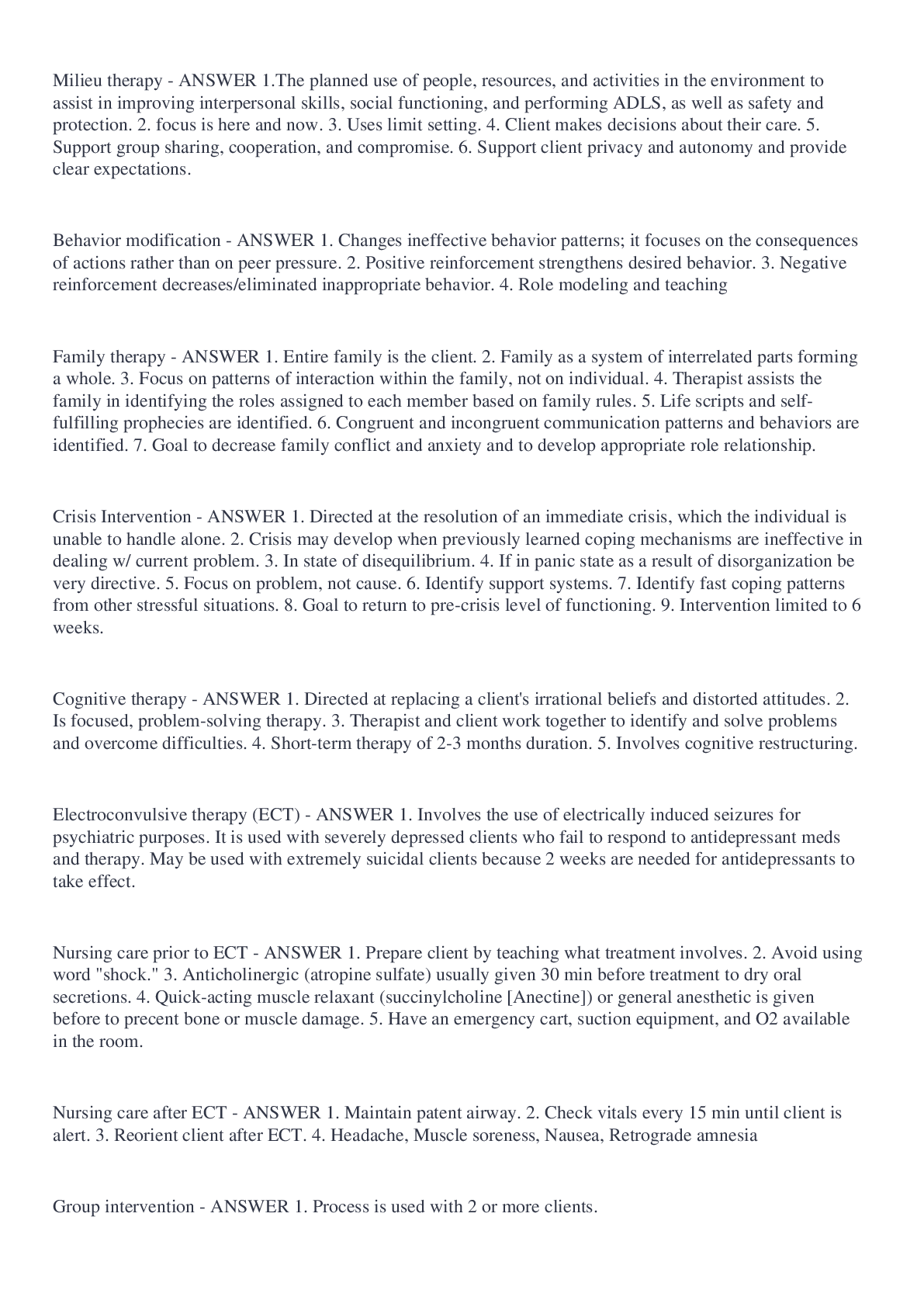
Reviews( 0 )
Document information
Connected school, study & course
About the document
Uploaded On
Jul 26, 2022
Number of pages
25
Written in
Additional information
This document has been written for:
Uploaded
Jul 26, 2022
Downloads
0
Views
20



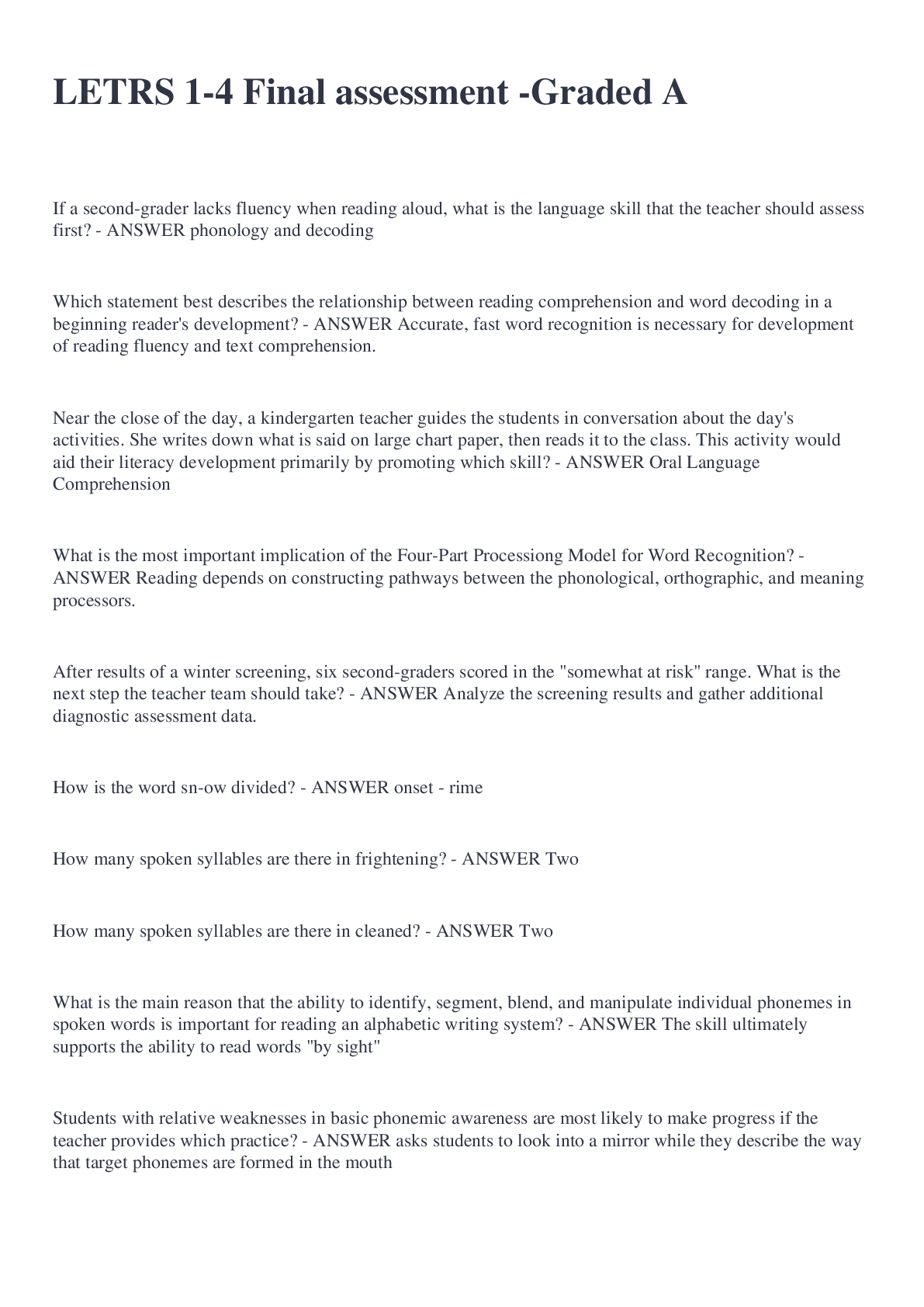


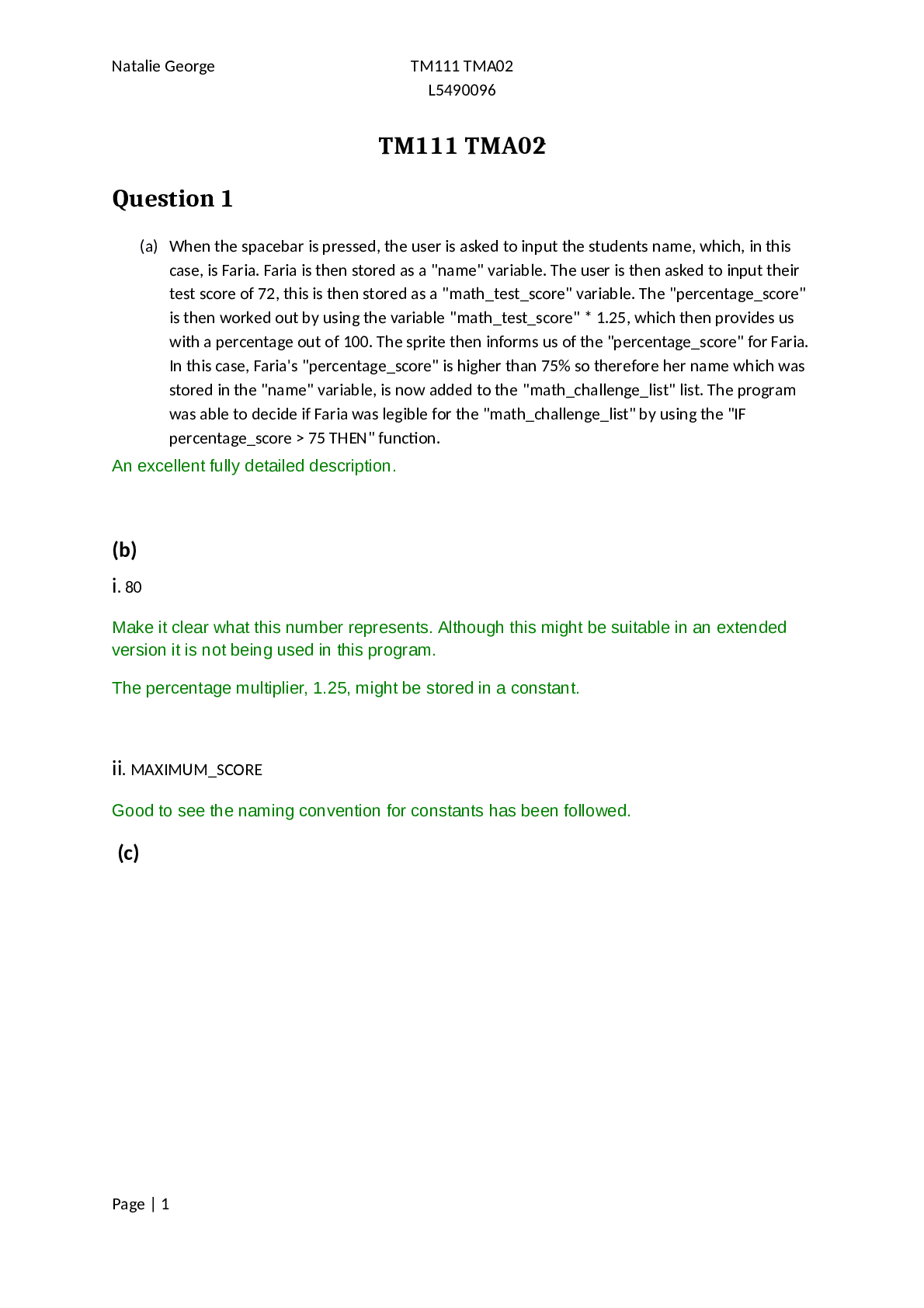


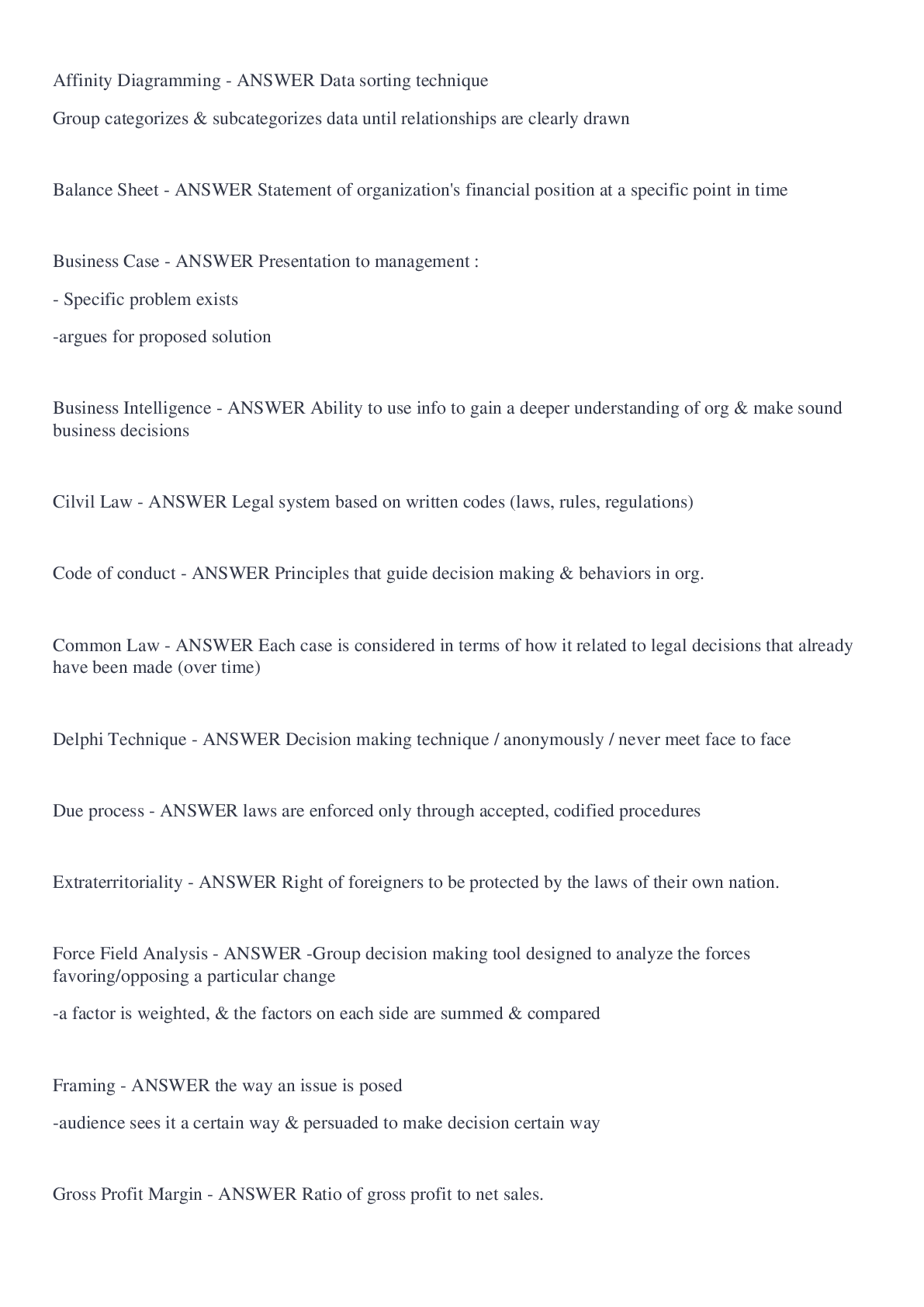

.png)
